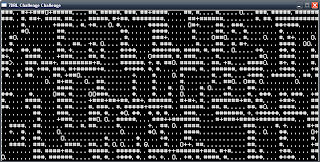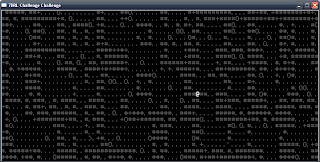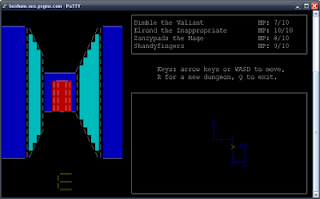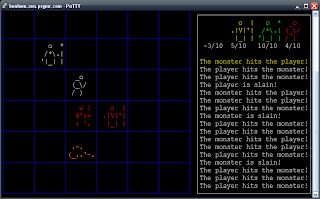Next up is the confusingly named 7DRL Challenge Challenge. I would’ve gone with a more descriptive name like “Time Attack” or “Time’s Up!” or “Where the @#$%^# is that damned down staircase??”.
This game uses the LOVE engine, which is some kind of 2D lua game-making framework. Since my game requires both python and pygame, I can’t really complain about downloading LOVE, so away we go.
First problem — this game is way too small! Apparently some people in the forums had the same problem. Since I was determined to play this game I found a solution (others may not be so forgiving):
- Extract the .love file
- edit the “player.lua” file
- rhe last line says “fixed.ttf’, 8
- change the 8 to 16, or (presumably) any other number
- rezip the files
- re-name the archive to .love
- re-launch the new .love package
 |
| Aaah… much better! |
Now, with that out of the way, we can play the game. Here is the good part: this game is fun! The goal is to get yourself (@) to the down stair (>) on each level. In your way will be pits (0) walls (#) and doors (+). So, what’s the catch?
You need to do this in about 30 seconds.
It is a perfect example of a first 7DRL entry. It has a simple potentially non-genre-standard mechanic (time is ticking in real time) and a simple presentation. The way the level fades to black as your time runs out is quite ingenious and also quite maddening! Never before have I mashed my numpad keys so frantically in a roguelike. Running, Running, RUNNNIIINNNGGG!!!!
 |
| Noooooo! (fade to black) |
So yeah, it’s fun.
One beef — is every level “winnable”? There were a few times when I couldn’t see a way through.
A few suggestions:
- exit highlighting — show me the exit when the level starts. I wasted the first 5-10 seconds of every level just looking for the > symbol. Or maybe just change the color?
- time tokens — if you can’t find the exit quick enough, run for one of these to give yourself some extra time
Good for what it is. A solid 7DRL.










